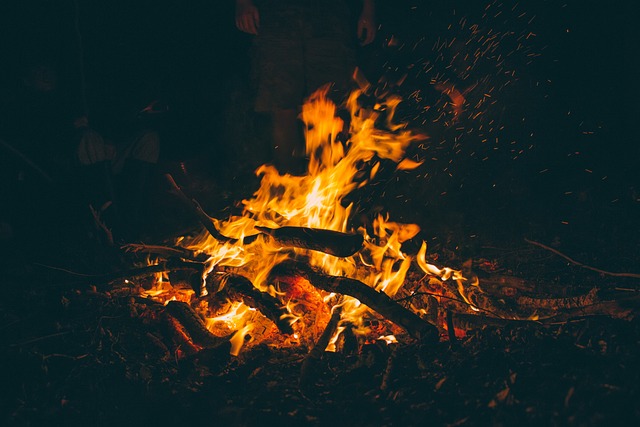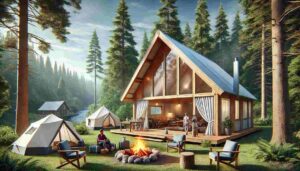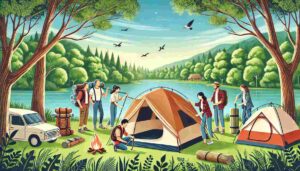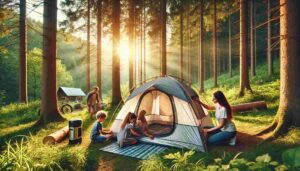There’s something undeniably magical about gathering around a crackling fire, sharing stories, and feeling the warmth on a cool evening. But have you ever wondered just how hot a campfire can get?
The temperature of a campfire can vary depending on factors like fuel type, oxygen supply, fire size, and weather conditions. On average, a well-established campfire can reach temperatures of around 900 to 1,200 degrees Fahrenheit (480 to 650 degrees Celsius) at its hottest point. Remember to prioritize safety and responsible fire management while enjoying the cozy warmth of a campfire.
But there’s much more to know. In this guide, I’ll explore the factors that determine campfire temperatures, learn about different units of measurement, discover practical examples of campfire heat, and, most importantly, ensure you’re staying safe while enjoying the cozy embrace of a campfire. Get ready to be enlightened and amazed by the remarkable world of campfire heat!
So, grab a marshmallow or a cup of hot cocoa, and let’s embark on this adventure together.
What Determines the Temperature of a Campfire?
When it comes to the temperature of a campfire, several factors come into play. Let’s take a closer look at what influences the heat produced by those mesmerizing flames.
- Fuel Type and Quality: The type and quality of the fuel you use in your campfire have a significant impact on its temperature. Different types of wood, such as hardwoods or softwoods, have varying energy content and burn characteristics. Hardwoods like oak or maple burn longer and produce more heat compared to softwoods like pine or spruce. Dry, seasoned wood also burns hotter than wet or green wood, as it ignites more readily and efficiently.
- Oxygen Supply: Just like any fire, a campfire requires oxygen to sustain and intensify its heat. The amount of oxygen available to the fire influences the rate of combustion and, consequently, the temperature. Proper airflow is crucial for maintaining a hot fire. Adequate ventilation allows the fire to breathe and burn more efficiently, resulting in higher temperatures. Conversely, limited airflow can hinder combustion, leading to a cooler fire.
- Fire Size and Arrangement: The size and arrangement of your campfire also affect its temperature. A larger fire, with a well-stacked arrangement of logs and kindling, has the potential to generate more heat. This is because a larger fire has a greater surface area for combustion, enabling more fuel to burn simultaneously. Building a well-structured fire with layers of fuel, such as kindling, logs, and smaller branches, creates a sustainable and hotter fire.
- Weather Conditions: Believe it or not, weather conditions can impact the temperature of your campfire. Wind, in particular, plays a significant role. A strong breeze can increase the rate of combustion by supplying more oxygen to the fire, resulting in a hotter flame. Conversely, heavy winds can also create a turbulent environment, causing the flames to flicker and reducing overall heat output. It’s important to be mindful of wind direction and adjust your campfire setup accordingly.
Experimenting with different fuel types, ensuring proper airflow, and adjusting fire size and arrangement will allow you to create the perfect campfire for warmth and enjoyment. Remember, it’s all about finding that sweet spot where the flames dance and the heat embraces you in its comforting glow.
Understanding Campfire Heat Measurements
Now that you have a grasp on what influences the temperature of a campfire, let’s dive into the topic of campfire heat measurements. While you may not have a thermometer handy during your outdoor adventures, understanding the concept of temperature and how it relates to your campfire experience is fascinating.
- Common Units of Temperature: When it comes to measuring temperature, we often encounter two widely used units: Fahrenheit (°F) and Celsius (°C). In the United States, Fahrenheit is the primary unit of measurement, while Celsius is more commonly used in many other parts of the world. Throughout this discussion, we’ll refer to both units to cater to our diverse audience.
- Average Campfire Temperature Range: While it’s challenging to provide an exact temperature for a campfire due to the many variables involved, we can estimate a typical range. A well-established campfire can reach temperatures of around 900 to 1,200 degrees Fahrenheit (480 to 650 degrees Celsius) at its hottest point. Remember, this is just an approximation, and actual temperatures can vary depending on the factors we discussed earlier.
- Radiant Heat and Perception of Warmth: When sitting by a campfire, you experience not only the actual temperature but also the radiant heat. Radiant heat refers to the transfer of heat energy through electromagnetic waves. It’s the reason you can feel warmth on your face and body when you’re close to a fire, even if the ambient air temperature isn’t particularly high. This radiant heat makes the campfire experience feel even cozier and more comforting.
- Heat Dissipation and the Heat Zone: As you move away from the campfire, you’ll notice a decrease in temperature. Heat dissipates with distance, and the feeling of warmth gradually diminishes. The area where you can feel the direct heat of the fire is often referred to as the “heat zone.” It’s the region where the radiant heat is strong enough to provide a noticeable warming effect. Beyond the heat zone, the temperature drops, and the fire’s influence on the surroundings becomes less perceptible.
Understanding campfire heat measurements allows us to appreciate the science behind the warmth we experience. While we may not have precise instruments to gauge the exact temperature, being aware of the general range, the impact of radiant heat and the concept of the heat zone enriches our campfire encounters.
Campfire Temperature Examples
Let’s explore some campfire temperature examples to provide a clearer understanding of how different factors can influence the heat of a fire. Keep in mind that these are general examples and the actual temperatures may vary depending on various variables.
- Low Heat: Imagine a small campfire with minimal fuel and a limited oxygen supply. In this scenario, the fire may produce a lower temperature. You might experience a gentle warmth within the immediate vicinity of the fire, but it may not radiate significant heat beyond that. This type of campfire is perfect for creating a cozy ambiance on a mild evening or for toasting marshmallows.
- Moderate Heat: Now picture a well-built campfire with proper airflow and a balanced arrangement of fuel. In this case, the fire can generate a moderate level of heat. You’ll feel a comfortable warmth around the fire and within a few feet from it. This type of campfire is ideal for chilly nights when you want to gather closely with friends or family, sharing stories and enjoying the comforting heat.
- High Heat: In scenarios where you have a larger fire, optimal fuel, and ample airflow, you can experience higher temperatures. The flames will be more vigorous, and the heat produced will be noticeably stronger. With such a campfire, you may feel the warmth even from a greater distance, and the heat zone expands. This type of fire is perfect for colder nights when you need substantial warmth and might want to cook over the fire.
It’s crucial to prioritize safety when working with hotter fires. Be mindful of the size and location of your campfire, maintain a safe distance, and take precautions to prevent accidents or burns. Responsible fire management ensures an enjoyable and secure campfire experience for everyone involved.
Campfire temperatures can vary based on factors such as fuel type, fire size, airflow, and weather conditions. Experimenting with different setups and observing how they affect the temperature can be a fun way to explore the world of campfire heat. Just remember to always exercise caution and respect the power of fire.
Safety Precautions Around Campfire Heat
When enjoying the warmth and ambiance of a campfire, it’s essential to prioritize safety. Campfires can be mesmerizing and comforting, but they also pose potential risks if not handled responsibly. Here are 7 crucial safety precautions to keep in mind when around campfire heat:
- Choose a Suitable Location: Select a safe and designated area for your campfire. Ensure it’s away from overhanging branches, dry vegetation, tents, or any flammable objects. Clear the surrounding area of debris and create a fire ring or use a fire pit if available. This helps contain the fire and reduces the risk of accidental spread.
- Keep a Safe Distance: Maintain a safe distance from the campfire. A good rule of thumb is to stay at least 6 to 10 feet away from the flames. Be mindful of the heat zone, as radiant heat can still cause burns even at a distance. Encourage everyone to respect these boundaries, especially children and pets.
- Use Fire-Resistant Materials: If possible, set up your campfire on a non-combustible surface like gravel or sand. If you’re using rocks to contain the fire, ensure they are heat-resistant and won’t explode from the heat. Avoid using flammable materials like plastic or synthetic fabrics near the fire.
- Keep a Fire Extinguisher or Water Source Nearby: Have a fire extinguisher, a bucket of water, or a hose readily available in case of emergencies. These can help extinguish the fire quickly if it starts to get out of control. Remember to fully extinguish the fire before leaving the campsite or going to sleep.
- Never Leave the Fire Unattended: Never leave a campfire unattended, even for a short period. Assign someone to be responsible for monitoring the fire at all times. This ensures that any sparks or embers are properly managed, reducing the risk of accidental fires.
- Extinguish the Fire Properly: When you’re finished with the campfire, make sure to extinguish it completely. Use water or sand to douse the flames, and then stir the ashes to cool them down. Repeat this process until you can touch the ashes without feeling any residual heat. Properly extinguishing the fire prevents the risk of re-ignition.
- Follow Local Regulations: Be aware of any fire regulations or restrictions in the area you’re camping. Some regions may have specific rules regarding campfires, especially during dry seasons or in protected areas. Adhere to these regulations to prevent wildfires and maintain a safe environment.
By following these safety precautions, you can enjoy the warmth and beauty of a campfire while minimizing the risks. Responsible fire management not only protects the environment but also ensures the safety of everyone involved, allowing you to have a worry-free and enjoyable experience around the campfire.
Fun Facts About Campfire Heat
Campfire heat is not only fascinating but also holds some intriguing and unexpected facts. Let’s explore a few fun facts about campfire heat that will ignite your curiosity:
- Ignition Temperatures: Did you know that different materials have specific temperatures at which they ignite? For example, paper typically ignites at around 451 degrees Fahrenheit (233 degrees Celsius). Knowing these temperatures can be helpful for starting a fire or understanding the behavior of different objects near the campfire.
- Animal Adaptations: Some animals have evolved to take advantage of campfire heat. For instance, certain species of birds, like the Australian mallee fowl, build nests near fires to incubate their eggs. The radiant heat from the fire helps maintain optimal temperature conditions for successful incubation.
- Campfire Cooking: Campfires are not only great for providing warmth but also for cooking delicious meals. With the right equipment, you can cook everything from traditional s’mores and hot dogs to more elaborate dishes like foil-wrapped vegetables or grilled meat. The campfire’s heat adds a unique smoky flavor to the food, enhancing the outdoor cooking experience.
- DIY Projects: Campfire heat can be harnessed for various DIY projects. For example, you can use heat to create charred wood, known as “shou sugi ban,” a traditional Japanese wood preservation technique. Additionally, you can use campfire heat to soften or shape certain materials, like heat-molding plastic for repairs or crafting.
- Heat’s Effect on Metal: Intense campfire heat can dramatically impact metal objects. When heated and then rapidly cooled, some metals can undergo changes in their physical properties, like increased hardness or brittleness. This knowledge has been utilized by blacksmiths and metalworkers throughout history to shape and temper metals.
- Mesmerizing Blue Flames: In certain conditions, you may notice blue flames dancing in your campfire. These blue flames are often a result of the combustion of gases, such as methane or carbon monoxide, present in the fire. The mesmerizing blue hue adds an enchanting touch to the overall campfire experience.
Campfire heat is not only about warmth but also presents a world of intriguing possibilities. Whether it’s the temperature at which materials ignite, the adaptability of animals, or the creative applications of campfire heat, there’s always more to explore and learn.
Conclusion
Campfire temperature is a result of diverse factors – fuel type, oxygen supply, fire size, and weather conditions. When a campfire is well-established, it can reach scorching temperatures of 900 to 1,200°F (480 to 650°C) at its peak. As you revel in the soothing warmth of a campfire’s embrace, never forget to prioritize safety and responsible fire management. Enjoy the enchanting dance of the flames while ensuring the protection of yourself, others, and the environment.
Campfires have a magical way of bringing people together, captivating us with their radiant warmth. Understanding the dynamics of campfire heat adds a new dimension to this experience. From selecting the right fuel to optimizing oxygen supply and fire size, each element contributes to the temperature of the flames.
Remember to cherish these moments responsibly, balancing the joy of a cozy campfire with the commitment to safety and environmental stewardship. So, gather around the campfire, let its heat kindle your spirits, and create lasting memories under the starry skies.
Next, Read: Is Sycamore Good Firewood? Here’s What You Need To Know










